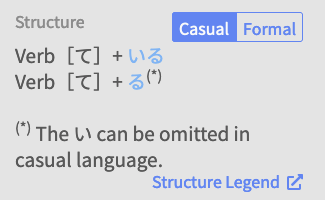Perhaps this is a question with an obvious answer, but I’m just looking for a little human feedback to make sure I understand things correctly.
The specific example I tripped up on:
電車(でんしゃ)は東京(とうきょう)に行(い)っ ています 。
The train is in Tokyo. (The train has gone to Tokyo and is there.)
[Like a previous example, this sentence can be interpreted as “The train is going to Tokyo.”]
Plus the Meaning note for some context:
[When ている is used with a verb that expresses a change that happens within a moment, it indicates a state of being that is the result of the realization of that verb.
Example: 怒る (to get angry) → realization (got angry) → 怒っている (to be mad/to be in a state of anger) not “to be getting mad”
As you can see, the verb in dictionary form expresses the starting moment, and ている expresses the result and current state.]
I mistakenly answered: いってある. Which, if I had made it polite as I was supposed to, would have been: いってあります. Which is still incorrect, but at least it would have been ‘more correct’  .
.
My question is this:
Is the ‘point’ of this grammar point specifically that てある (or てあります) is not the correct way to express continued-state in this context, because the verbs are about instantaneous change (starting moment), so the correct way to express continued state is with ている instead?
Or, am I actually misunderstanding てある also, and it doesn’t actually express continued-state in precisely the way that I was imagining it did? (In fact, I just woke up, so I’m still a tiny bit groggy on my memory of these distinctions; at least, that’s my story, and I’m sticking with it!  )
)
Any tips/suggestions on how I could be thinking about this mistakenly, and how I might better remember/understand how and when to use てある instead of ている, and vice versa? Is this distinction already covered by existing grammar points, and I’m just having fuzzy recollection, perhaps (probably?)? … 
And, a minor note/issue/question, @Pushindawood:
In the Examples section, the specific example sentence’s note is as I quoted above, namely:
“[Like a previous example, this sentence can be interpreted as “The train is going to Tokyo.”]”
But when I was actually presented with the question for review, the More hint actually only says:
“[This sentence can be interpreted as “The train is going to Tokyo.”]”.
Is this as it was intended to be, or is there an unintentional mismatch between the two hints/notes here?
It does actually make sense that the ‘previous example’ part would be omitted during an actual review, but I’m just curious, since I kind of would have expected that the identical text would be used in both places. Mightn’t that sometimes make it so you have to make any updates to hints/notes in two different places?
Context: From my programming days, I’m used to avoiding duplicated data and/or code as scrupulously as possible: the so-called ‘copy pasta’ curse, where copying and pasting stuff generally leads to ‘spaghetti code’ (hence the ‘pasta’ pun  ).
).
But maybe it was a deliberate decision to allow the hints to be different in both places, since they are being seen in two somewhat different contexts?
Just curious how it was/is intended to work.  Cheers!
Cheers! 
 You may come across verb [て] + て (来てて). This is the て-form of ている - 来ていて with い omitted.
You may come across verb [て] + て (来てて). This is the て-form of ている - 来ていて with い omitted.








 .
.
 ).
).


 始じまっている
始じまっている